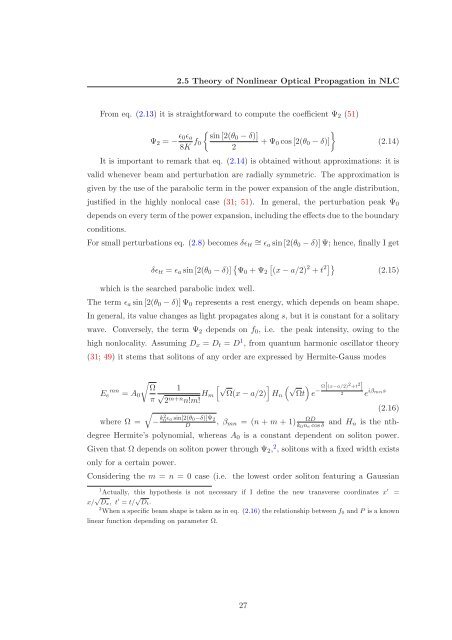Solitons in Nonlocal Media
Solitons in Nonlocal Media
Solitons in Nonlocal Media
Create successful ePaper yourself
Turn your PDF publications into a flip-book with our unique Google optimized e-Paper software.
2.5 Theory of Nonl<strong>in</strong>ear Optical Propagation <strong>in</strong> NLC<br />
From eq. (2.13) it is straightforward to compute the coefficient Ψ2 (51)<br />
Ψ2 = − ǫ0ǫa<br />
8K f0<br />
<br />
s<strong>in</strong>[2(θ0 − δ)]<br />
+ Ψ0 cos [2(θ0 − δ)]<br />
2<br />
(2.14)<br />
It is important to remark that eq. (2.14) is obta<strong>in</strong>ed without approximations: it is<br />
valid whenever beam and perturbation are radially symmetric. The approximation is<br />
given by the use of the parabolic term <strong>in</strong> the power expansion of the angle distribution,<br />
justified <strong>in</strong> the highly nonlocal case (31; 51). In general, the perturbation peak Ψ0<br />
depends on every term of the power expansion, <strong>in</strong>clud<strong>in</strong>g the effects due to the boundary<br />
conditions.<br />
For small perturbations eq. (2.8) becomes δǫtt ∼ = ǫa s<strong>in</strong>[2(θ0 − δ)] Ψ; hence, f<strong>in</strong>ally I get<br />
δǫtt = ǫa s<strong>in</strong>[2(θ0 − δ)] 2 2<br />
Ψ0 + Ψ2 (x − a/2) + t <br />
which is the searched parabolic <strong>in</strong>dex well.<br />
(2.15)<br />
The term ǫa s<strong>in</strong>[2(θ0 − δ)] Ψ0 represents a rest energy, which depends on beam shape.<br />
In general, its value changes as light propagates along s, but it is constant for a solitary<br />
wave. Conversely, the term Ψ2 depends on f0, i.e. the peak <strong>in</strong>tensity, ow<strong>in</strong>g to the<br />
high nonlocality. Assum<strong>in</strong>g Dx = Dt = D 1 , from quantum harmonic oscillator theory<br />
(31; 49) it stems that solitons of any order are expressed by Hermite-Gauss modes<br />
Ee mn = A0<br />
Ω<br />
π<br />
1<br />
√ 2 m+n n!m! Hm<br />
√ √ <br />
Ω(x − a/2) Hn Ωt e −Ω[(x−a/2) 2 +t 2 ]<br />
2 e iβmns<br />
(2.16)<br />
<br />
where Ω = − k2 0ǫa s<strong>in</strong>[2(θ0−δ)]Ψ2<br />
ΩD<br />
D , βmn = (n + m + 1) k0ne cos δ and Hn is the nthdegree<br />
Hermite’s polynomial, whereas A0 is a constant dependent on soliton power.<br />
Given that Ω depends on soliton power through Ψ2, 2 , solitons with a fixed width exists<br />
only for a certa<strong>in</strong> power.<br />
Consider<strong>in</strong>g the m = n = 0 case (i.e. the lowest order soliton featur<strong>in</strong>g a Gaussian<br />
1 Actually, this hypothesis is not necessary if I def<strong>in</strong>e the new transverse coord<strong>in</strong>ates x ′ =<br />
x/ √ Dx, t ′ = t/ √ Dt.<br />
2 When a specific beam shape is taken as <strong>in</strong> eq. (2.16) the relationship between f0 and P is a known<br />
l<strong>in</strong>ear function depend<strong>in</strong>g on parameter Ω.<br />
27
















